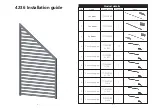
PAGE 29 OF 126
NIGHT SCAN VERTICAL, VERTICAL COMPLETE, AND VERTICAL HDT
OPERATING INSTRUCTIONS
TP-4836201-H
MAY 2021
5 Installation
This section describes the physical and electrical installation of the Night Scan Vertical, Night
Scan Vertical Complete, and Night Scan Vertical Heavy Duty Towing (HDT) mast systems. This
section provides the general procedures that must be followed to ensure a successful
installation. Be sure to read and understand the entire installation procedure and the Safety
Summary in Section 1 before beginning installation.
5.1 Mounting Location Requirements
The following factors must be included when selecting an appropriate mounting location:
1. Your system is designed to withstand adverse weather conditions, however it cannot be
submerged in water. If the system is mounted in a well, provide adequate drainage. A
minimum of four 1 inch (25 mm) diameter drain holes (one per corner) are recommended.
2. Ensure that the mounting surface is flat and has sufficient room and strength to hold the
system. Reinforce as necessary. Table 5-1 shows the shear force and the bending moment
load acting at the base plate (bottom of mast) of the mast due to wind loading. The load
values correspond to the maximum wind load ratings in the Technical Data Section. The
combination of the support bracket (or internal roof mount kit) and the base plate support
structure must resist these loads to adequately support the mast.
Note: Shear force is larger with shorter masts because rated wind load is higher.
Table 5-1 Mounting Structure Reaction Loads
Model
Base Shear Force
(lb. / N)
Base Moment
(ft.-lb. / Nm)
Night Scan Vertical
4.3-15
495 / 2202
4681 / 6345
5.4-17
412 / 1833
4695 / 6366
6-20
352 / 1566
4658 / 6316
7-25
293 / 1304
4678 / 6343
8-30
250 / 1112
4684 / 6351
Night Scan Vertical Complete
1.6-2.3
495 / 2202
4681 / 6345
Night Scan Vertical HDT
1.8-4.5
412 / 1833
4695 / 6366
Summary of Contents for Night Scan Vertical 4.3-15
Page 2: ......
















































